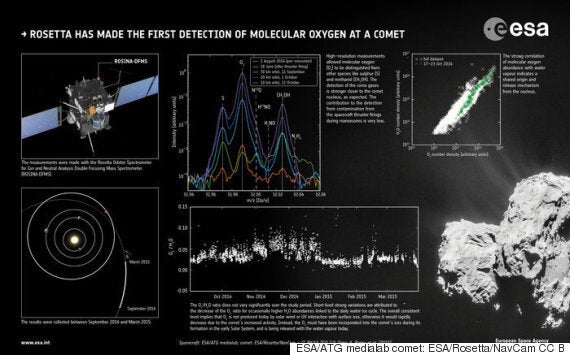Scientists have expressed surprise at the latest data to filter through from the Rosetta spacecraft, which has shown comet 67P to have an oxygen rich atmosphere.
This is the first time oxygen molecules have been detected in the outpouring of gasses originating from the comet.
The discovery changes what researchers know about comet formation.

Due to oxygen's highly reactive nature, the team initially did not expect to find it in its unattached form.
“We weren’t really expecting to detect O2 at the comet – and in such high abundance – because it is so chemically reactive, so it was quite a surprise,” says Kathrin Altwegg, principal investigator of the Rosetta Orbiter Spectrometer for Ion and Neutral Analysis instrument, ROSINA.
“It’s also unanticipated because there aren’t very many examples of the detection of interstellar O2," she added.
"And thus, even though it must have been incorporated into the comet during its formation, this is not so easily explained by current Solar System formation models.”
In an article published by the journal Nature, the team noted that oxygen was most likely incorporated into the nucleus of the comet during its formation.
"Current Solar System formation models do not predict conditions that would allow this to occur," the report states.
SEE ALSO:
There are two processes, photolysis and radiolysis, that scientists believe could be responsible for oxygen formation on the comet.
In photolysis, light particles known as photons break apart the molecules while radiolysis involves more energetic photons.
Earlier this year, the ESA's spacecraft gave the scientific community more food for thought as they suggested that the comet's "distinct and unexpected features," could be signs of extraterrestrial life.
While the latest oxygen find does not shed any further light on this, it does pave the way forward for a more thorough explanation on how our Solar System formed.
“This is an intriguing result for studies both within and beyond the comet community, with possible implications for our models of Solar System evolution,” says Matt Taylor, ESA’s Rosetta project scientist.